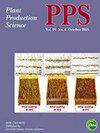成熟稻谷糊粉层可视化平板法的建立与应用
IF 1.3
3区 农林科学
Q2 AGRONOMY
引用次数: 1
摘要
米糠油是米糠(主要由米糠胚和糊粉组成)的一种重要成分,因其丰富的成分和对人体健康的益处而越来越受到人们的关注。为了提高产量,育种者选择了扩大胚胎和增厚糊粉层。然而,后者的育种受到观察糊粉粉性状的耗时和劳动密集型过程的阻碍。在这里,我们建立了一种新的可视化糊粉层的方法,包括成熟颗粒在板上的嵌入,半颗粒的二色染色和计算机辅助图像分析。使用这种“盘子法”,可以比标准的冷冻组方法更有效地处理和检查一批多达100粒固定在盘子上的谷物,而标准的冷冻组方法只能单独处理谷物。此外,平板法与冷冻组法在糊粉面积(r = 0.92)和平均糊粉厚度(r = 0.93)方面高度相关。这种新方法使我们能够快速评估超过22,000粒诱变的“Mizuhochikara”的糊粉表型,每天700-1000粒。结果,成功分离到1个糊粉层增厚的突变系。图示摘要:成熟稻谷中糊粉层可视化的平板法本文章由计算机程序翻译,如有差异,请以英文原文为准。
Development and Application of a Plate Method for Visualizing Aleurone Layers in Mature Rice Grains
ABSTRACT Rice bran oil, a valuable ingredient of rice bran (composed mainly of embryo and aleurone), is gaining increasing attention for its abundance and benefits for human health. To increase production, breeders have selected for enlarged embryos and thickened aleurone layers. However, breeding for the latter is impeded by the time-consuming and labor-intensive process of observation of aleurone traits. Here, we established a new method for visualizing aleurone layers comprising embedding of mature grains in a plate, dichromatic staining of half grains, and computer-assisted image analysis. With this ‘plate method’, a batch of up to 100 grains fixed on the plate can be handled and examined more efficiently than the standard cryomicrotome method, which only processes the grains individually. In addition, the results obtained from the plate method were highly correlated with that of the cryomicrotome method in terms of aleurone area (r = 0.92) and mean aleurone thickness (r = 0.93). This new method allowed us to rapidly assess the aleurone phenotypes of more than 22,000 mutagenized grains of ‘Mizuhochikara’, with 700–1000 grains per day. As a result, one mutant line with thickened aleurone layer was successfully isolated. Graphical abstractA plate method for visualizing aleurone layers in mature rice grains
求助全文
通过发布文献求助,成功后即可免费获取论文全文。
去求助
来源期刊

Plant Production Science
农林科学-农艺学
CiteScore
5.10
自引率
4.00%
发文量
27
审稿时长
>36 weeks
期刊介绍:
Plant Production Science publishes original research reports on field crops and resource plants, their production and related subjects, covering a wide range of sciences; physiology, biotechnology, morphology, ecology, cropping system, production technology and post harvest management. Studies on plant production with special attention to resource management and the environment are also welcome. Field surveys on cropping or farming system are also accepted. Articles with a background in other research areas such as soil science, meteorology, biometry, product process and plant protection will be accepted as long as they are significantly related to plant production.
 求助内容:
求助内容: 应助结果提醒方式:
应助结果提醒方式:


